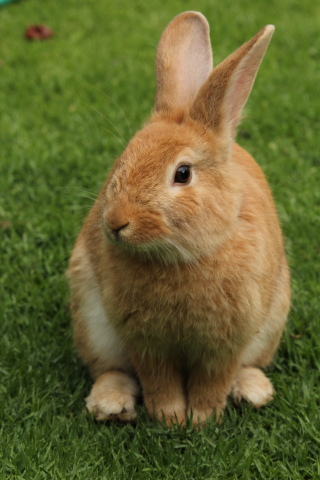Amelia the Tropicat - kočičí námořník
Ne každá bezprizorní kočka najde svůj domov. Kolika se ale povede najít si domov na lodi? :)
Not only dogs and cats communicate with us non-verbally. Even rabbits tell us what and how they feel with their non-verbal expressions such as postures, gestures and sounds. It helps us understand what mood they are just in. Let’s look at expression which are the most typical ones for these little friends.


Sniffing
As well as other animals, also rabbits rely on their own noses for recognizing well-known people and strangers. However, when the sniffing turns to poking with its nose, your little furry friend wants attention and wants you to caress it and spend time with it.
Stretching
Not many people know that rabbits can stretch the same way cats do. They basically do the same thing with their back. They stand on all four paws and make a subtle noise. Rabbits stretch like this mainly after they wake up or stop relaxing. It looks really cute.
Licking
Rabbits express their affection by this. If they lick you, you know you are one of the people they like and they want to express their gratitude for being good to them. If a rabbit licks you, you may cuddle or caress it. You will show you like it as well by it.
Territory marking
Rabbits mainly use their poop, urine and glands under their chin to mark their territory. These furry friends usually mark their territory by wiping its chin on the things it considers or wants to consider its own. Every rabbit, may it be male or female, has to have a clearly defined territory. It is necessary for them. In the case of urine marking, it is worse as this form of marking comes with an unpleasant smell.
Snuggling up
Even rabbits can sometimes feel endangered. You can see your rabbit is scared of something very easily – it snuggles up. Its aim is to look as small as possible for the potential enemy so it doesn’t even see it. Its pulse is faster and breathing louder which is similar humans.
And what about noises?
If a rabbit is happy and for example, you are cuddling, you can hear it creak with its teeth. That is a noise you might be happy with as it shows the animal is satisfied. However, if it becomes louder and turns into grating, your pet shows you something hurts and it may even seem kind of absent or even apathetic. The third most typical noise is squeaking. Most often, it occurs in young pets and it signalizes fear.
And what is the most typical behaviour of your rabbit?


Ne každá bezprizorní kočka najde svůj domov. Kolika se ale povede najít si domov na lodi? :)


Epilepsie je stejně jako u lidí nemoc celoživotní a nevyléčitelná. Toto onemocnění se může vyskytnout u jakéhokoli psa nebo kočky všech ras a v každém věku. Podíváme se na to, co vlastně epilepsie je, jaké jsou její hlavní příčiny a jak poznáte...


V tomto cyklu se společně podíváme, jak se daří kočkám a psům ve světě. Kde je lidé hýčkají a předcházejí si je, kde naopak mazlíci strádají a jejich situace je kritická. Dnes se s vámi podělím o svou zkušenost s Albánií.


Poslední rozloučení s domácím mazlíčkem, zvláště se psy a kočkami, kteří s námi žijí dlouhá léta, je psychicky velmi náročné. Kdo to zažil, dá mi za pravdu. Pro lidi, kteří se necítí v těchto chvílích na to, aby organizovali kremaci či pohřeb svého...


U větších domácích zvířat, zejména u psů, je pro nás péče o mazlíčkovy zuby samozřejmá. Jakmile zvíře dosáhne několika let věku, je nutné být čím dál pečlivější, protože usazující se zubní plak a potažmo kámen vede k zánětům dásní, které jsou pro celý...


Britský designér a vynálezce Dominic Wilcox otevřel v Londýně svou novou výstavu s názvem Play More. Dokazuje, že umění není určeno jen pro lidi. Jedná se totiž o první výstavu určenou výhradně pro psy. Najdete tu obrazy, bazén s kuličkami nebo...


Klonování patří k výdobytkům moderní doby. Leckoho tedy asi nepřekvapí, že svět má už nějaký ten rok i svého prvního naklonovaného psa. Pojmenovali ho Snuppy, což si jistě dobře zapamatujete kvůli podobnosti s pouze jinak psaným jménem Snoopy, jehož...


Nikomu bych nepřála se dostat do situace, kdy by veterinární záchrannou službu potřeboval. Stát se ale může cokoli a je lepší být na takové případy připraven. Koneckonců, může to znamenat rozdíl mezi životem a smrtí vašeho mazlíka.


Možná i vy máte doma malého čtyřnohého stresaře. V takovém případě čtěte pozorně, třeba tu narazíte na něco, co jste ještě ve snaze zbavit parťáka stresu nezkoušeli.


Pravděpodobně jste se setkali s názorem, že mnohem důležitější než to, co psovi říkáte, je, jakým způsobem (tónem) to říkáte. Ukazuje se ale, že psi lidské řeči mohou rozumět lépe, než jim obecně přisuzujeme.


Každý z nás určitě rád fotí svoje mazlíky. Ne vždy ale fotky vyjdou podle očekávání. Tady je proto pár rad, jak fotografování zvládnout, a co nejlépe zachytit ty naše chlupaté společníky.


Mohlo by se zdát, že čím menší zvíře, tím méně péče bude vyžadovat. Nenechte se však mýlit. I pokud máte doma myšku, křečka nebo třeba morče, měli byste péči o něj přizpůsobovat ročnímu období a situacím, jimž je vystavujete. V parných dnech, jaké nás...